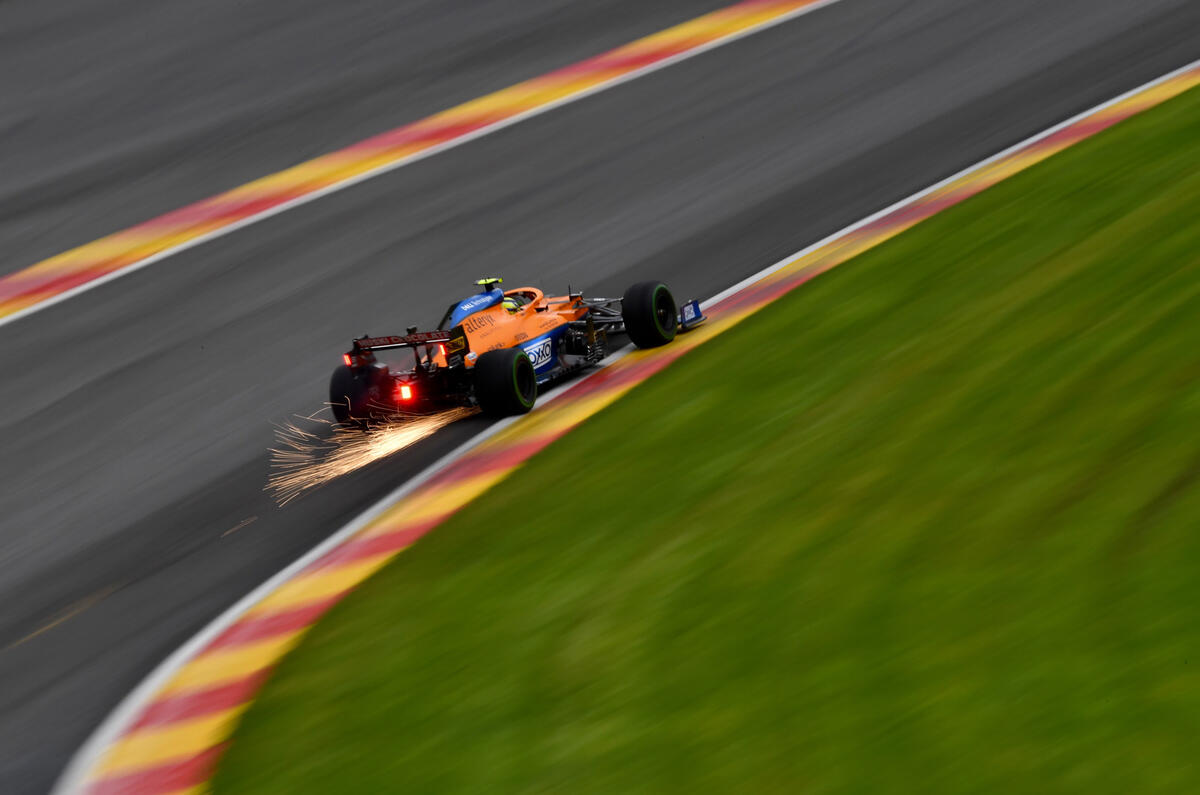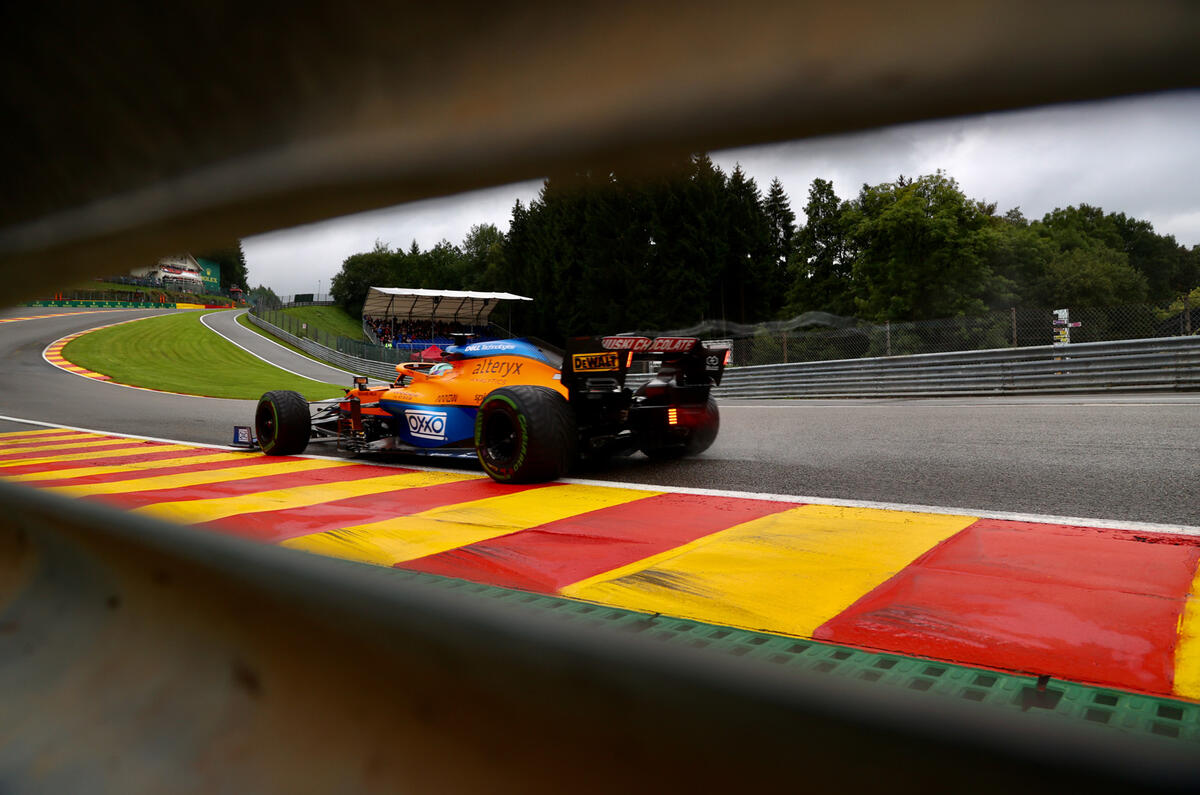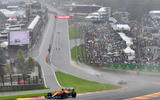Stefan Bellof died there in a Group C sports car when he made an ill-judged move on Jacky Ickx in 1985; Alex Zanardi shook Ayrton Senna to his core by the size of his Formula 1 shunt in 1993; and yet six years later, cavalier team- mates Jacques Villeneuve and Ricardo Zonta put their lives on the line in a high-risk bet over who could take it flat. That both wrecked their cars is grist to the age-old contradiction of Eau Rouge and Raidillon: that they’ve always been equally deadly and enticing at the same time.
The world’s most famous corner sequence remains the signature flourish of the magnificent Spa-Francorchamps circuit, scene of the not-so-magnificent 2021 Belgian Grand Prix. But as picturesque and daunting as it has always been, it paled in comparison to the fearsome Burnenville and MastaKink in the minds of apprehensive racing drivers contemplating the original 8.76-mile circuit.
Doughty Lancastrian Brian Redman, hero of the Porsche 917 and survivor of a terrifying F1 crash at Les Combes in 1968, has since admitted to tearfully praying for deliverance on any night before he was to race at Spa. Drivers back then tended to pack their bags and leave their hotel rooms tidy when they walked out on race morning. They would glance back as they locked the door, wondering if they would ever return.
Spa has been sanitised since then, of course. But even in its shortened form (used since the 1980s) and with new acres of asphalt run-off at the likes of Pouhon and Blanchimont, this remains a circuit to focus the minds of all racers. The place still demands respect.
Lucky escapes
A spotlight has swung its uncomfortable glare back on Eau Rouge and Raidillon in recent weeks, following a series of nasty close calls. Back at the turn of August, Williams F1 reserve Jack Aitken suffered fractures to his vertebrae and collarbone and lung contusions in a violent collision early in the Spa 24 Hours GT race. Then in qualifying for the Belgian GP, McLaren’s Lando Norris was left spinning like a top after losing control in atrocious conditions. A day earlier, six drivers had survived a pile-up in qualifying for the supporting W Series race. The dull whump of single- seaters slamming into one another, then the sight of Beitske Visser crawling from her inverted Tatuus. limping to the side of the track and collapsing in pain from a (luckily minor) leg injury made for deeply uncomfortable viewing.
That no one died in these accidents is a testament to the wonders of modern race car design and the circuit safety measures already in place. But it’s only been two years since Formula 2 driver Anthoine Hubert wasn’t so lucky here. The worst can happen, has happened and is likely to again, but that doesn’t condone a laissez-faire approach.
Beyond the kerbs
Racing drivers love Eau Rouge because it’s at the heart of why they do what they do. They relish the plunge down from the La Source hairpin, how they must steel themselves for the swoop left then immediate right, before popping over the top of Raidillon on a wave of momentum to whoosh along the Kemmel Straight. No one wants to dilute the track, and yet drivers are demanding something be done – not to the layout itself but to the run-off beyond its kerbs, and the evidence from the past month suggests that it’s beyond time.
The likes of Aitken, Alfa Romeo reserve Callum Ilott and others who have spoken out should be commended for doing so. Nothing, not even Eau Rouge, should be sacrosanct just because it has always been hairy. They’re too young to remember the Belgian GP of 1994 when, in the wake of the deaths of Roland Ratzenberger and Senna at Imola, F1 was so spooked that it added a chicane to completely neuter Eau Rouge. Thankfully, that proved to be a one-off. No one, including Aitken and co, would welcome such a reconfiguration now. That’s not what they’re demanding. This sequence should be tough; in fact, I would argue it should be harder to take flat. But the consequences when it does go wrong need to be much less severe.
Change is coming
Again, there’s nothing new here: both Spa’s bosses and the FIA were well aware before the recent accidents that the risk-reward odds are too dicey at Eau Rouge and Raidillon, and indeed a plan has been drawn up as part of a programme to make Spa suitable for motorcycle racing again. (Gulp. Is that really wise?) The circuit is still reeling from the tragic killing of its CEO, Nathalie Maillet, but even something that awful shouldn’t derail this project. The expensive problem is that the barriers on the left of the rise must be pushed back towards the encroaching forest, to stop cars pinging out into the middle of the track, as in Aitken’s crash.
But it’s more than that: at the top of the hill, cars are often spat into heavy impacts on the right too, as with poor Hubert: again, the barriers are simply too close to the circuit. The forests and topography don’t lend themselves to easy solutions. But the FIA knows what’s required.
Deep breaths, deep pockets: now is the time to act. But how about the point that Eau Rouge should be harder to take f lat, as it was when Villeneuve and Zonta tried it? Gravel traps are out of fashion, as they’re far from a perfect solution: cars can dig in and flip when they hit them sideways. But if there were gravel on the outside of Eau Rouge, just as there used to be, removing the safety net of asphalt, drivers would be forced to temper their approach. Combined with greater run-off, Eau Rouge would remain great and harder to get right but with a dialled-down threat of unhappy outcomes when it inevitably does go wrong.
READ MORE
Verstappen wins rain-soaked, two lap F1 Belgian G
Advertising Feature | The BMW M4: from road to track (and back again)













Join the debate
Add your comment
About the W Series pile up, cars 1, 2, and 3 all lost control at the same spot, in exactly the same way. Car 4 lost control at the same spot but in a different way because the driver's approach was slightly different. Car 5 lost control in the same place and in the same way as cars 1 to 3 but managed to gather it together and pass by the run off, and then cars 6 and 7 for whatever reason, came in almost aligned but it was hard to see how they lost control, pressumably the same way as car 4.
Whether it was raining heavily or not there was clearly something up with the surface at that particular location, which, it should be noted, is at much lower elevation to where the collisons were taking place so it's unlikely that drivers 5, 6, and 7 could see what was happening up top but it begs the question; what were the flags showing at that point, and how were the drivers reacting. No doubt the race stewards will have investigated and will report accordingly.
GP drivers and some other car sports now learn a Circuit sitting in a Virtual sort of gaming machine, it saves money, and the mention of the driver last through who just drove through the middle of it, well, it was taught to me that if you see something in front of who like a Rabbit, Pheasant, it was safer to just hit them than try to avoid them, now, maybe that's what your driving part of your Brain does automatically?
I would just add that the track was not 'very wet' in the Formula W qualifying. There was no spray, the track was virtually dry and the cars were on slicks.
By the drivers own admission it had just started to drizzle, and they all said that they felt they 'had to go for it' or lose the opportunity for a good grid position.
This is stupidity in the first degree.....and could have maimed or killed. You cant beat the laws of physics girls, particularly with slick tyres.
The last girl to crash in that group, as far as I can see, just kept the wheel straight with no attempt to avoid....like a rabbit in headlights.
Back to school me thinks, this is not Eau Rouge/Raidilllon's fault.
Norris's spin was definitely in (super) wet conditions!